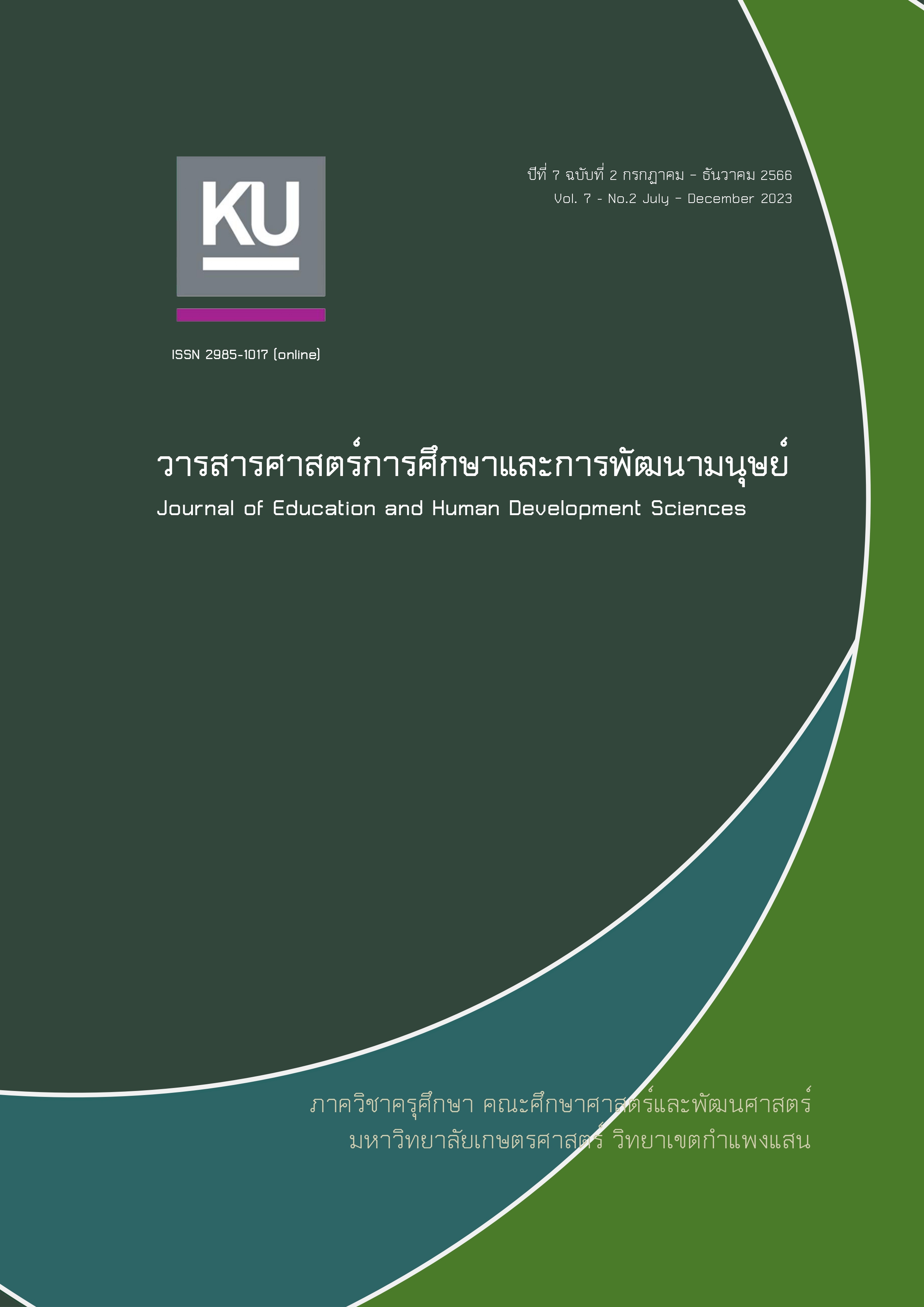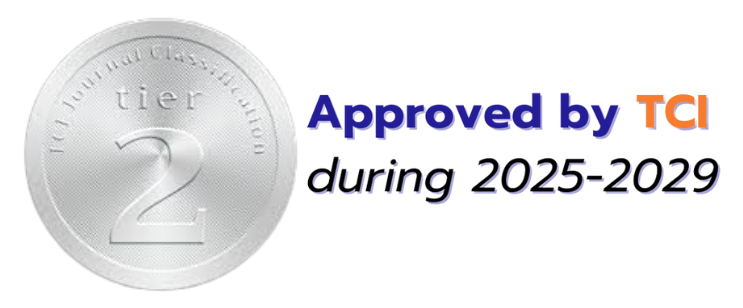ผลการใช้วิธีการสอนแบบ 4S ในวิชานาฏศิลป์ เพื่อส่งเสริมความฉลาดทางอารมณ์ของนักเรียนระดับชั้นมัธยมศึกษาตอนปลาย โรงเรียนสาธิตแห่งมหาวิทยาลัยเกษตรศาสตร์ วิทยาเขตกำแพงแสน ศูนย์วิจัยและพัฒนาการศึกษา|
The effect of using the 4S learning management in dramatic arts subjects to promote emotional intelligence of high school students Kasetsart University Laboratory School Kamphaeng Saen Campus Educational, Research and Development Center
Keywords:
วิธีการสอนแบบ 4S, วิชานาฏศิลป์, ความฉลาดทางอารมณ์, 4S teaching method, dramatic arts, emotional intelligenceAbstract
การวิจัยนี้มีมีวัตถุประสงค์ 1) เพื่อศึกษาผลการใช้วิธีการสอนแบบ 4S ในวิชานาฏศิลป์ เพื่อส่งเสริมความฉลาดทางอารมณ์ของนักเรียนระดับชั้นมัธยมศึกษาตอนปลาย และ 2) เพื่อเปรียบเทียบความฉลาดทางอารมณ์ก่อนและหลังการใช้วิธีการสอนแบบ 4S ในวิชานาฏศิลป์ของนักเรียนในระดับชั้นมัธยมศึกษาตอนปลาย กลุ่มตัวอย่าง คือ นักเรียนชั้นมัธยมศึกษาปีที่ 6 โรงเรียนสาธิตแห่งมหาวิทยาลัย เกษตรศาสตร์ วิทยาเขตกำแพงแสน ศูนย์วิจัยและพัฒนาการศึกษา ภาคเรียนที่ 1 ปีการศึกษา 2565 จำนวน 130 คน ที่ได้มาจากวิธีสุ่มอย่างง่าย (Sample Random Sampling) โดยการจับฉลาก เป็นวิจัยเชิงทดลอง (Experimental Research) ใช้กลุ่มเดียวทดสอบก่อน - หลัง One – Group Pretest-Posttest Design เครื่องมือที่ใช้ในการวิจัย ได้แก่ แบบประเมินความฉลาดทางอารมณ์ สำหรับวัยรุ่น (อายุ 12 – 17 ปี) ของกรมสุขภาพจิต กระทรวงสาธารณสุข โดยเลือกใช้เฉพาะส่วนที่เป็นองค์ประกอบด้านสุข จำนวน 16 ข้อ และแผนการจัดการเรียนรู้โดยวิธีการสอน แบบ 4S เรื่อง การแสดงนาฏศิลป์สร้างสรรค์ สำหรับนักเรียนระดับชั้นมัธยมศึกษาปีที่ 6 ผ่านการตรวจสอบความถูกต้องและความเหมาะสม โดยผู้เชี่ยวชาญ จำนวน 3 ท่าน มีค่าเท่ากับ 4.53 อยู่ในระดับเหมาะสมมากที่สุด วิเคราะห์และเปรียบเทียบด้วยสถิติพื้นฐาน ค่าเฉลี่ย ส่วนเบี่ยงเบนมาตรฐาน (S.D.) และสถิติ t – test
ผลการวิจัย พบว่า การใช้วิธีการสอนแบบ 4S ประกอบด้วย ขั้นที่ 1 นำเสนอสิ่งเร้า (Stimulus) ขั้นที่ 2 ขั้นเตรียมความพร้อม (Start) ขั้นที่ 3 ขั้นฝึกปฏิบัติ (Step) และขั้นที่ 4 ขั้นนำเสนอผลงานและประเมิน (Star) ในวิชานาฏศิลป์ พบว่า การใช้วิธีการสอนแบบ 4S สามารถส่งเสริมให้นักเรียนมีความฉลาดทางอารมณ์สูงขึ้น และเมื่อเปรียบเทียบความฉลาดทางอารมณ์ (ด้านสุข) ก่อนและหลังการใช้วิธีการสอนแบบ 4S ในวิชานาฏศิลป์ พบว่า หลังการใช้วิธีการสอนแบบ 4S ในวิชานาฏศิลป์สูงกว่าก่อนการใช้วิธีการสอนแบบ 4S อย่างมีนัยสำคัญทางสถิติที่ระดับ .05
This research had two objectives 1) to study the effect of using the 4S teaching method in the subject of dancing arts to promote emotional intelligence of senior high school students and 2) to compare the levels of emotional intelligence of the senior high school students before and after using the 4S teaching method in the subject of dancing arts. The study sample selected by the Sample Random Sampling consisted of 130 senior high school students of Mathayom Sueksa 6 of Kasetsart University Laboratory School Kamphaeng Saen Campus, Educational Research and Development Center. It was an experimental research of One – Group Pretest-Posttest Design. The study instruments were an Emotional Intelligence Assessment for adolescents (12-17 years old) of the Department of Mental Health, Ministry of Public Health consisting of 16 items of the assessment of the emotional intelligence of happiness and the lesson plan of the 4S teaching method on creative dance performance. These 2 study instruments had also been checked the accuracy and suitability by three experts, with a value of 4.72 at the most appropriate level. The data were analyzed in terms of arithmetic means, standard deviation and t-test.
The results revealed that using the 4S teaching method in the subject of dancing arts can make the senior high school students to have higher emotional intelligence; moreover, when the levels of emotional intelligence of the senior high school students before and after using the 4S teaching method in the subject of dancing arts were compared, the students’ level of emotional intelligence after were significally (p<.05) higher than that before.
Downloads
References
Chinnapong, P. (2013). Why dancing arts is important to Thai children. Retrieved from https://mgronline.com/qol/detail/9560000137042.
Chuchuen, T., & Wanichwattanaworachai, S. (2015). The development of student development activities on creative dancing arts. Thai-Myanmar Relations For elementary school students. Veridian E-Journal, Thai edition, Humanities, Social Sciences and Arts, 8(1), 252.
Jinda, A. (2019). The development of an art teaching model, analyzing 3 aspects to promote critical thinking and emotional intelligence for undergraduate students Visual Arts Faculty of Fine and Applied Arts [Doctor of Education, Dhurakij Pundit University].
Jintalai, W. (2017). Creation of dancing arts activities. develop students' creativity Grade 1, Wat Tan En School (Sophonchanupatham) [Master of Education, Srinakharinwirot University].
Kartharat, T., & Pattayanon, P. (2018). The use of dancing arts activities with the SMILE learning management model. Pattanasil Academic Journal, 2(Special), 71.
Ministry of Education. (2003). The Emotional Intelligence Handbook (8 ed.). Printing House of the Agricultural Cooperatives Association of Thailand: Nonthaburi
Ministry of Education. (2008). Learning management manual for art learning subjects. Bangkok: Teachers Council Ladprao Printing House.
Ministry of Public Health, R. I. (2016). A handbook for caring for school-aged children with behavioral-emotional problems. for health personnel (trial version) (2 ed.): Printing House of the Agricultural Cooperative Society of Thailand Limited.
National Board of Education, O. (2000). Reforming the learner's learning is the most important. Bangkok: Learning Reform Subcommittee Office of the National Education Commission.
Petchsri, W. (2018). The development of learning management model 4S strand 3 dramatic art grade 5. Ubon Ratchathani Research and Evaluation Journal, 7(1), 21-30.
Phinyophanuwat, R. (2013). Sampling Design - Office of Registration and Measurement. Nonthaburi: Sukhothai Thammathirat Open University.
Ploysophon, A. (2013). Group Counseling Based on Reasons, Emotions and Behaviors Using Music as a Media for Developing Emotional Intelligence and Cognitive Skills Social media of adolescents in Bangkok [Master of Arts, Kasetsart University].
Samakbutr, P. (1995). The concept of inventing the dancing posture. Udon Thani: Department of Dramatic Arts Faculty of Humanities, Udon Thani Rajabhat Institute.
Sithisamarn, S. (Producer). (2021). Reducing tensions of children studying online. Retrieved from https://mgronline.com/qol/detail/9640000065988.
Srisa-Ard, B. (2013). Statistical Methods for Research (5 ed. Vol. 1). Bangkok: Suweeriyasan.
Wongrattana, C. (2010). Techniques for using statistics for research. Bangkok: Thep created printing.
Yuttawisuthi, S. (2000). EQ and success in life. Journal of Phrapokklao College of Nursing Chanthaburi, 11(1), 38-42.







